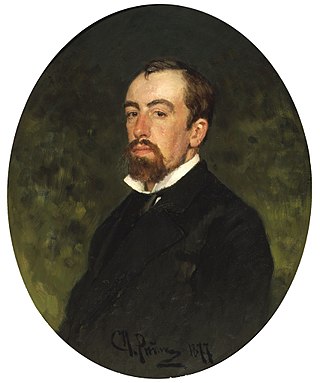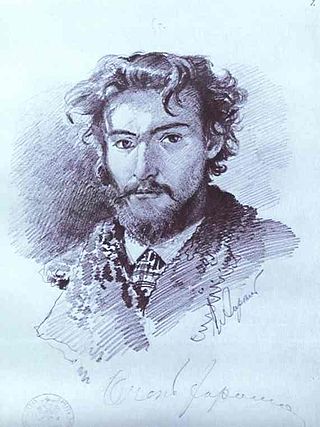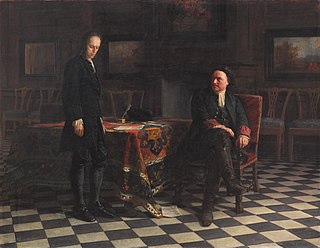
Nikolai Vasilyevich Nevrev (Russian : Никола́й Васи́льевич Не́врев; 1830 in Moscow – 3 May 1904 in Mogilev Governorate) was a Russian painter who specialized in genre and historical scenes.

Nikolai Vasilyevich Nevrev (Russian : Никола́й Васи́льевич Не́врев; 1830 in Moscow – 3 May 1904 in Mogilev Governorate) was a Russian painter who specialized in genre and historical scenes.
Nevrev was born to a family of merchants. His first art lessons came from his stepfather, who was a drawing teacher. At the age of 21, Nevrev entered the Moscow School of Painting, Sculpture and Architecture (MSPSA), where he studied under the Russian-Italian painter, Mikhail Scotti. [1] Upon graduating in 1855, he was named a "Free Artist". [ citation needed ] In the 1860s, Nevrev painted one of his masterpieces, "The Bargain" (1866), in which he depicted the sale of a serf. [2] Some other paintings focused on criticisms of the Church.
He temporarily stopped working in the 1870s, for unknown reasons, but began painting historical art in the 1880s. In 1881, he became a member of the Association of Travelling Art Exhibitions. His best work during this time were his genre paintings, each exhibiting a human moral. From 1887 to 1890, he taught at the MSPSA and, in 1889, became curator at the Tretyakov Gallery. [1]
In 1898, following the death of Pavel Tretyakov, he was offered the position of Director at the gallery, but declined, citing old age and poor health. At the age of 74, in great financial distress, he committed suicide by shooting himself at his estate near Mogilev. [1]
On 25 September 1980, the Soviet Union issued a 6 kopek postage stamp commemorating the 150th anniversary of his birth (together with that of Konstantin Flavitsky). [3]
An international open-air painting festival is held annually in his honor in the Mogilev Region of Belarus.

Ilya Yefimovich Repin was a Russian painter who was born in what is now Ukraine. He became one of the most renowned artists in Russia in the 19th century. His major works include Barge Haulers on the Volga (1873), Religious Procession in Kursk Province (1880–1883), Ivan the Terrible and His Son Ivan (1885); and Reply of the Zaporozhian Cossacks (1880–1891). He is also known for the revealing portraits he made of the leading Russian literary and artistic figures of his time, including Mikhail Glinka, Modest Mussorgsky, Pavel Tretyakov, and especially Leo Tolstoy, with whom he had a long friendship.

Pavel Mikhaylovich Tretyakov was a Russian businessman, patron of art, collector, and philanthropist who gave his name to the Tretyakov Gallery and Tretyakov Drive in Moscow. His brother Sergei Tretyakov was also a famous patron of art and a philanthropist.

Peredvizhniki, often called The Wanderers or The Itinerants in English, were a group of Russian realist artists who formed an artists' cooperative in protest of academic restrictions; it evolved into the Society for Travelling Art Exhibitions, in short Peredvizhniks, in 1870.

Vasily Dmitrievich Polenov was a Russian landscape painter associated with the Peredvizhniki movement of realist artists. His contemporaries would call him the “Knight of Beauty” as he embodied both European and Russian traditions of painting. His vision of life was summarized as following: “Art should promote happiness and joy”. As a painter and a humanist, he would truly believe in the civilizing mission of Art, Culture and Education.

Ivan Nikolayevich Kramskoi was a Russian Realist painter and art critic. He was an intellectual leader of the art movement known as the Peredvizhniki between 1860 and 1880.

Pavel Petrovich Chistyakov was a Russian painter and art teacher. He is known for historical and genre scenes as well as portraits.

Valentin Alexandrovich Serov was a Russian painter and one of the premier portrait artists of his era.

The State Tretyakov Gallery is an art gallery in Moscow, Russia, which is considered the foremost depository of Russian fine art in the world.

Viktor Mikhaylovich Vasnetsov was a Russian artist who specialised in mythological and historical subjects. He is considered a co-founder of Russian folklorist and romantic nationalistic painting, and a key figure in the Russian Revivalist movement.

Mikhail Vasilyevich Nesterov was a Russian and Soviet painter; associated with the Peredvizhniki and Mir iskusstva. He was one of the first exponents of Symbolist art in Russia.

Nikolay Nikanorovich Dubovskoy was a Russian landscape painter, associated with the Peredvizhniki. Together with Isaac Levitan, he helped create what came to be known as the "Landscape of Mood".

Nikolai Nikolaevich Ge was a Russian painter who was influential in the development of Russian symbolism. He was famous for his works on historical and religious subjects.

Alexei Kondratyevich Savrasov was a Russian landscape painter and creator of the lyrical landscape style. The most famous and a celebrated work is The Rooks Have Returned.

Fyodor Alexandrovich Vasilyev was a Russian Imperial landscape painter who introduced the lyrical landscape style in Russian art.

Nikolay Gustavovich Shilder was a Russian painter. Member of the Imperial Academy of Arts.

Michel Angelo Pietro Scotti, russified as Mikhail Ivanovich Scotti was a Russian painter of Italian descent, best known for his portrait and history paintings, typical of late Romantic/Academic style.

Vasili Vladimirovich Pukirev was a Russian genre painter in the Realistic style.

Piotr Petrovich Belousov was a Soviet Ukrainian and Russian graphic artist, painter, art teacher, professor of the Ilya Repin Leningrad Institute of Painting, Sculpture and Architecture, People's Artist of the USSR, and a corresponding member of the Academy of Arts of the USSR, who lived and worked in Leningrad. He was regarded as one of the brightest representatives of the Leningrad school of painting, being most famous for his portraits and historical paintings.

They Did Not Expect Him is a painting by realist artist Ilya Repin made between 1884 and 1888. It depicts the return of a narodnik from exile and his family's reaction. The painting is part of Repin's "Narodniki" series, which includes four other artworks.

The painting Peter the Great Interrogating the Tsarevich Alexei Petrovich at Peterhof was created by the Russian artist Nikolai Ge (1831–1894) and completed in 1871. The painting is stored in the State Tretyakov Gallery in Moscow. The dimensions of the painting are 135.7 cm by 173 cm. Ge's work offers a psychological interpretation of a historical drama set in 1718. The painting depicts Peter I and his son Alexei Petrovich, who has been accused of preparing to seize power, in the interior of the Monplaisir Palace in Peterhof. Before pronouncing sentence, Peter I gazes into his son's eyes, still hoping to discern signs of remorse.